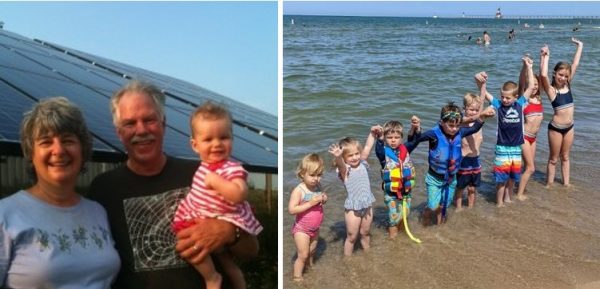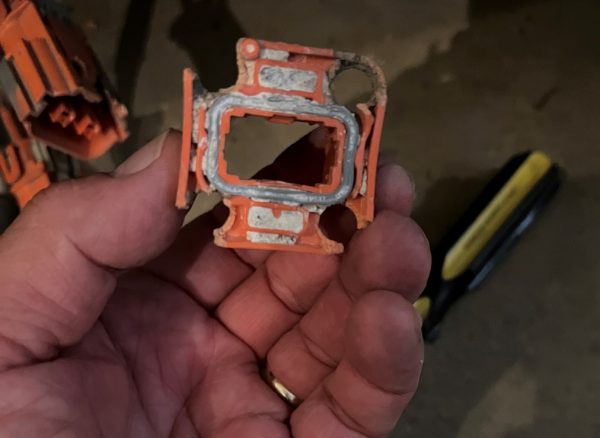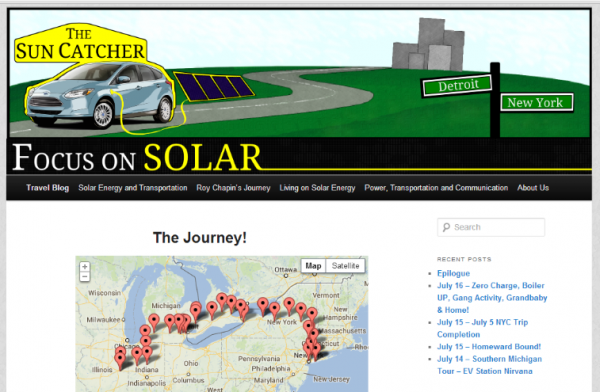Ten years ago, Deb and I took a unique vacation during July, 2012. I wrote a blog describing our vacation, which is reprinted here - PDF: 10th Anniversary of The Sun Catcher’s Journey! We drove 1650 miles in our Ford Focus Electric Vehicle during our first two weeks of ownership. Most “Gen 1” EVs in 2012 could only drive 60 to 70 miles on a charge. Although this seems like a severe limitation, the majority of daily driving in the United States is much less. The adjacent pictures show our blog's webpage and an enlarged picture of our path and charging stops.
What happened on the trip? Lots! Deb and I were married (again), we met Bill Chapin (grandson of Roy Chapin, whose epic 1901 journey from Detroit to New York City we were honoring), had lunch with the engineers behind GM’s revolutionary EV1, and more!
We named our car The Sun Catcher, because it truly is a solar powered car. Our home in Urbana, Illinois, named Equinox House, is a “zero plus” home that collects energy for operating our home and energy needed for 6000-8000 miles of EV driving per year. Prior to our trip, our solar energy system had contributed more “excess” energy to the electrical grid than we needed for the trip. With the addition of a plug-in Ford C-Max to our garage in 2015, the additional EV energy exceeds our annual solar production, however, Urbana Illinois has a renewable energy rider ensuring that our energy deficit is made up with sustainably harvested energy.
Driving an early edition EV such as the 2012 Focus EV or Nissan Leaf is like driving a car with a 2 gallon gas tank. As impractical as that seems, most new technologies start out with the appearance of limitations that many view as insurmountable hurdles. A side benefit of such a short range is that there are no bathroom break arguments! Early home computers had a similar beginning. Archaic commands, serial data storage (cassette tapes), and tiny memories were just a few of their shortcomings.
EV technology coupled with renewable energy and important advances in home technologies (smart ventilation, LED lighting, flat screen TVs and computer monitors, heat pump water heaters, heat pump clothes dryers and low temperature comfort conditioning heat pumps) are putting us on a true path to healthy, comfortable and sustainable living. We are at an important juncture in time that decides whether we provide a better future for our children, or leave them with problems that accelerate out of control.
Deb and I purchased our EV in New York, near her childhood home on Long Island, because only a few dealers in California and New York were certified for selling Focus EVs when they first became available in 2012. We decided to take a leisurely drive to Detroit on our way home to Illinois, plugging the car in every 60 miles to recharge its batteries. Although a few other EV owners had driven further, I'm not sure if anyone at that point had driven such a distance in the manner we did. We simply hopped in the car and took off. Most other extended EV trips required some type of support crew, special car modifications, or a series of pre-planned stops. As I considered these things while planning our trip, Ben (my son and boss) said we should just get in the car and drive it home. And that's what we did. I think Ben was tired of my continuous stream of questions on whether we should do this or that.
Before beginning the blog, some brief sections from our defunct “FocusOnSolar.com” website discuss motivation for the trip, provide some electric vehicle (EV) information, and describes Roy D. Chapin's amazing 1901 long distance journey that inspired our trip, and introduced the world to long distance automotive travel.

The Sun Catcher is still with us! At 10 years old, we have driven 40,000 solar powered miles (about 4000 miles per year….we’re fortunate to live in a community with everything close by). The Sun Catcher and Ty have both required maintenance and repair operations over the past two months. Ty is now back in shape for crawling under cars, and expects to have The Sun Catcher motoring around town. Some plastic plugs in The Sun Catcher’s high voltage cables to the battery pack failed (see picture).

Want to learn more about the Sun Catcher's Journey? You can download a PDF below of the blog posts during the trip.



























